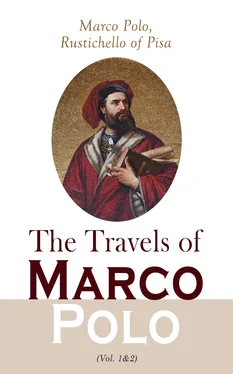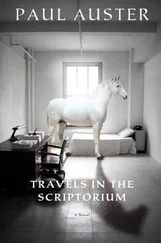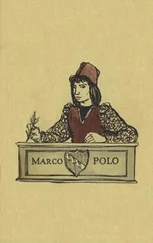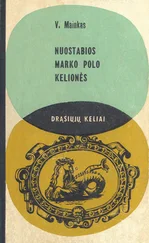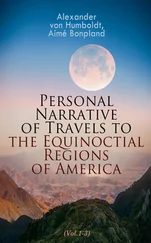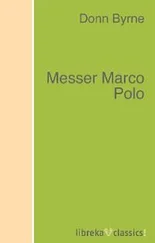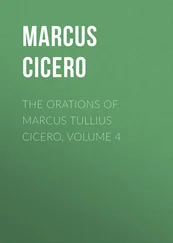Table of Contents
CONCERNING THE KINGDOM OF KERMAN.
Kerman is a kingdom which is also properly in Persia, and formerly it had a hereditary prince. Since the Tartars conquered the country the rule is no longer hereditary, but the Tartar sends to administer whatever lord he pleases.[NOTE 1] In this kingdom are produced the stones called turquoises in great abundance; they are found in the mountains, where they are extracted from the rocks.[NOTE 2] There are also plenty of veins of steel and Ondanique .[NOTE 3] The people are very skilful in making harness of war; their saddles, bridles, spurs, swords, bows, quivers, and arms of every kind, are very well made indeed according to the fashion of those parts. The ladies of the country and their daughters also produce exquisite needlework in the embroidery of silk stuffs in different colours, with figures of beasts and birds, trees and flowers, and a variety of other patterns. They work hangings for the use of noblemen so deftly that they are marvels to see, as well as cushions, pillows quilts, and all sorts of things.[NOTE 4]
In the mountains of Kerman are found the best falcons in the world. They are inferior in size to the Peregrine, red on the breast, under the neck, and between the thighs; their flight so swift that no bird can escape them.[NOTE 5]
On quitting the city you ride on for seven days, always finding towns, villages, and handsome dwelling-houses, so that it is very pleasant travelling; and there is excellent sport also to be had by the way in hunting and hawking. When you have ridden those seven days over a plain country, you come to a great mountain; and when you have got to the top of the pass you find a great descent which occupies some two days to go down. All along you find a variety and abundance of fruits; and in former days there were plenty of inhabited places on the road, but now there are none; and you meet with only a few people looking after their cattle at pasture. From the city of Kerman to this descent the cold in winter is so great that you can scarcely abide it, even with a great quantity of clothing.[NOTE 6]
NOTE 1.—Kermán is mentioned by Ptolemy, and also by Ammianus amongst the cities of the country so called ( Carmania ): " inter quas nitet Carmana omnium mater ." (XXIII. 6.)
M. Pauthier's supposition that Sirján was in Polo's time the capital, is incorrect. (See N. et E. XIV. 208, 290.) Our Author's Kermán is the city still so called; and its proper name would seem to have been Kuwáshír . (See Reinaud, Mém. sur l'Inde , 171; also Sprenger P. and R. R. 77.) According to Khanikoff it is 5535 feet above the sea.
Kermán, on the fall of the Beni Búya Dynasty, in the middle of the 11th century, came into the hands of a branch of the Seljukian Turks, who retained it till the conquests of the Kings of Khwarizm, which just preceded the Mongol invasion. In 1226 the Amir Borák, a Kara Khitaian, who was governor on behalf of Jaláluddin of Khwarizm, became independent under the title of Kutlugh Sultan. [He died in 1234.] The Mongols allowed this family to retain the immediate authority, and at the time when Polo returned from China the representative of the house was a lady known as the Pádishah Khátún [who reigned from 1291], the wife successively of the Ilkhans Abaka and Kaikhatu; an ambitious, clever, and masterful woman, who put her own brother Siyurgutmish to death as a rival, and was herself, after the decease of Kaikhatu, put to death by her brother's widow and daughter [1294]. The Dynasty continued, nominally at least, to the reign of the Ilkhan Khodabanda (1304–13), when it was extinguished. [See Major Sykes' Persia , chaps, v. and xxiii.]
Kermán was a Nestorian see, under the Metropolitan of Fars. ( Ilch. passim; Weil , III. 454; Lequien , II. 1256.)
["There is some confusion with regard to the names of Kermán both as a town and as a province or kingdom. We have the names Kermán, Kuwáshír, Bardshír. I should say the original name of the whole country was Kermán, the ancient Karamania. A province of this was called Kúreh-i-Ardeshír, which, being contracted, became Kuwáshír, and is spoken of as the province in which Ardeshír Bábekán, the first Sassanian monarch, resided. A part of Kúreh-i-Ardeshír was called Bardshír, or Bard-i-Ardeshír, now occasionally Bardsír, and the present city of Kermán was situated at its north-eastern corner. This town, during the Middle Ages, was called Bardshír. On a coin of Qara Arslán Beg, King of Kermán, of A.H. 462, Mr. Stanley Lane Poole reads Yazdashír instead of Bardshír. Of Al Idrísí's Yazdashír I see no mention in histories; Bardshír was the capital and the place where most of the coins were struck. Yazdashír, if such a place existed, can only have been a place of small importance. It is, perhaps, a clerical error for Bardshír; without diacritical points, both words are written alike. Later, the name of the city became Kermán, the name Bardshír reverting to the district lying south-west of it, with its principal place Mashíz. In a similar manner Mashíz was often, and is so now, called Bardshír. Another old town sometimes confused with Bardshír was Sírján or Shírján, once more important than Bardshír; it is spoken of as the capital of Kermán, of Bardshír, and of Sardsír. Its name now exists only as that of a district, with principal place S'aídábád. The history of Kermán, 'Agd-ul-'Olá, plainly says Bardshír is the capital of Kermán, and from the description of Bardshír there is no doubt of its having been the present town Kermán. It is strange that Marco Polo does not give the name of the city. In Assemanni's Bibliotheca Orientalis Kuwáshír and Bardashír are mentioned as separate cities, the latter being probably the old Mashíz, which as early as A.H. 582 (A.D. 1186) is spoken of in the History of Kermán as an important town. The Nestorian bishop of the province Kermán, who stood under the Metropolitan of Fars, resided at Hormúz." ( Houtum-Schindler , l.c. pp. 491–492.)
There does not seem any doubt as to the identity of Bardashir with the present city of Kermán. (See The Cities of Kirman in the time of Hamd-Allah Mustawfi and Marco Polo , by Guy le Strange, Jour. R. As. Soc. April, 1901, pp. 281, 290.) Hamd-Allah is the author of the Cosmography known as the Nuzhat-al-Kulub or "Heart's Delight." (Cf. Major Sykes' Persia , chap. xvi., and the Geographical Journal for February, 1902, p. 166.)—H. C.]
NOTE 2.—A MS. treatise on precious stones cited by Ouseley mentions Shebavek in Kermán as the site of a Turquoise mine. This is probably Shahr-i-Babek , about 100 miles west of the city of Kermán, and not far from Párez , where Abbott tells us there is a mine of these stones, now abandoned. Goebel, one of Khanikoff's party, found a deposit of turquoises at Taft, near Yezd. ( Ouseley's Travels , I. 211; J. R. G. S. XXVI. 63–65; Khan. Mém. 203.)
["The province Kermán is still rich in turquoises. The mines of Páríz or Párez are at Chemen-i-mó-aspán, 16 miles from Páríz on the road to Bahrámábád (principal place of Rafsinján), and opposite the village or garden called Gód-i-Ahmer. These mines were worked up to a few years ago; the turquoises were of a pale blue. Other turquoises are found in the present Bardshír plain, and not far from Mashíz, on the slopes of the Chehel tan mountain, opposite a hill called the Bear Hill (tal-i-Khers). The Shehr-i-Bábek turquoise mines are at the small village Kárík, a mile from Medvár-i-Bálá, 10 miles north of Shehr-i-Bábek. They have two shafts, one of which has lately been closed by an earthquake, and were worked up to about twenty years ago. At another place, 12 miles from Shehr-i-Bábek, are seven old shafts now not worked for a long period. The stones of these mines are also of a very pale blue, and have no great value." ( Houtum-Schindler , l.c. 1881, p. 491.)
Читать дальше
